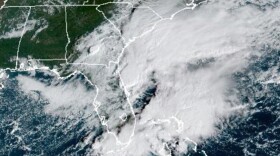New state maps detailing the risk of coastal flooding show some areas are less flood-prone than previously calculated.
If the updated maps are approved by the Federal Emergency Management Agency, more than 31,000 properties in coastal North Carolina will have their flood risk classification downgraded.
John Dorman is the project director for the state floodplain mapping program, and the assistant state emergency management director for risk management. He said the adjustments reflect new information on storm surges.
"We determined that the storm surge study for the coast hadn’t been updated since 1980," said Dorman.
The preliminary maps show 14,800 buildings along the coast moving out of the high velocity flood zone, where there’s the potential for up to three foot waves. Dorman said most will remain in 100 year floodplain, meaning property owners with federally-backed mortgages on buildings in that zone will still be required to buy flood insurance, but it could cost significantly less.
Additionally, about 17,000 properties currently in the 100 year floodplain will be reclassified as minimal risk. Owners in that zone may be able to drop their flood insurance altogether, but Dorman warned against it.
"As we release these maps, we're communicating that if you're near the coast, there's always a potential," said Dorman. "It's better to go ahead and keep your flood insurance and have a significantly reduced rating and cost for that."
Dare County Planning Director Donna Creef said her office has been has been getting calls from property owners trying to figure out what the new maps mean for them. She said while residents have been anticipating changes, many were surprised by the number of properties that have been reclassified.
"We had been hearing that there were changes in the elevation marks, but the amount of property that has been moved from the flood zone to the [minimal risk] zone was a surprise," said Creef.
Dorman agreed that extent of the reclassification was unexpected, but he said the storm surge modeling process has been rigorous, involving more than 770 storm scenarios for coastal regions.
"It’s been a surprise for us as well, but the modeling and the high resolution accurate elevation data is predicting that, and we think it is correct," he said.
Property owners can compare the old and new map on the state's flood risk website. Dorman said it could be up to two years before the updated map is formally adopted by the Federal Emergency Management Agency.







